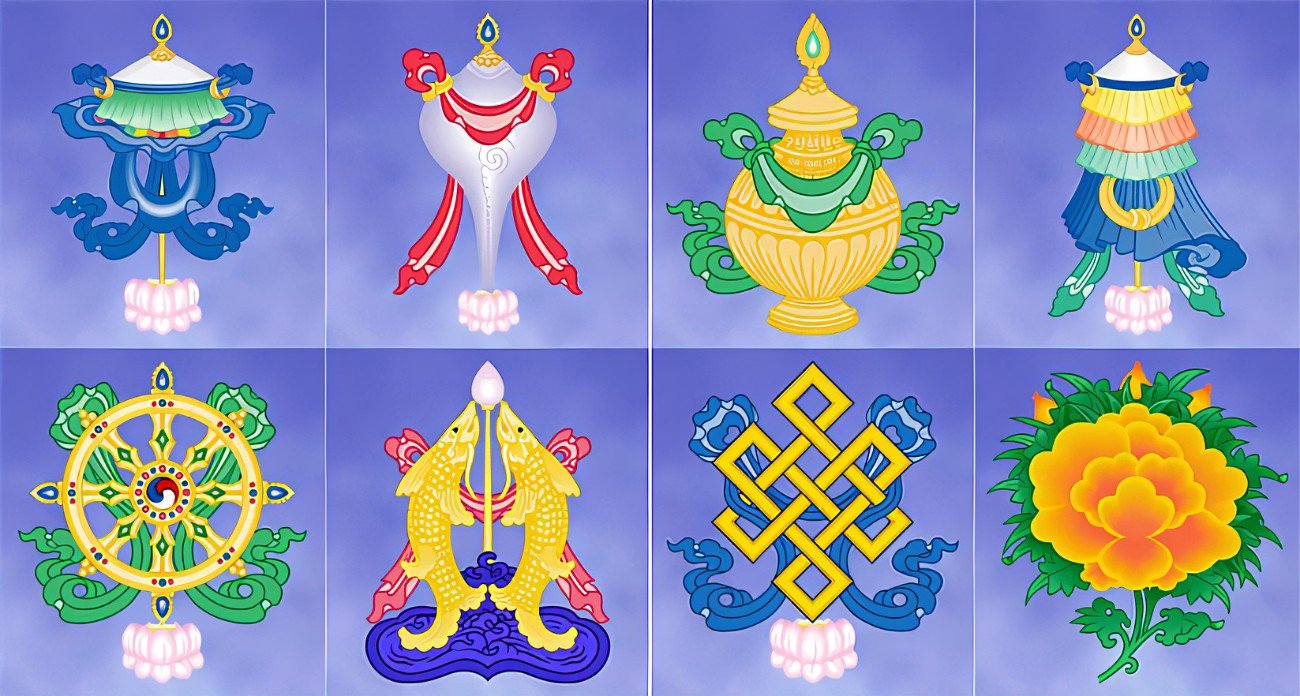2023 Sand Mandala - The 8 Auspicious Symbols
8 Auspicious Symbols represent the creation of positive potentials. This mandala can be used externally to help in successfully benefiting others in auspicious ways. The symbols are the umbrella, yellow fish, vase, lotus, white conch shell, glorious peu, banner and Dharma chakra.
1 - The Right Coiled White Conch: In Buddhism, a white conch that coils to the right represents the deep and melodious sound of the Dharma reaching far and wide, awakening beings from the slumber of ignorance. It urges the positive welfare of ourselves and others.
2 - The Precious Umbrella: The parasol is a symbol of royal dignity and protection from the heat of the sun. By extension, it represents protection from sufferings such as; illness, harmful forces, and obstacles in this life. It also protects from all kinds of temporary and enduring sufferings of the three lower realms, and the realms of men and gods in future lives. The ornate parasol usually is depicted with a dome, representing wisdom, and a "skirt" around the dome, representing compassion. Sometimes the dome is octagonal, representing the Eightfold Path. In other uses, it is square, representing the four directional quarters.
3 - The Victory Banner: The victory banner signifies the Buddha's victory over the demon Mara and over what Mara represents--passion, fear of death, pride and lust. It symbolizes victory over one's body, speech, and mind when faced with obstacles and negative forces. More generally, it represents the victory of wisdom over ignorance. There is a legend that the Buddha raised the victory banner over Mount Meru to mark his victory over all phenomenal things.
4 - The Two Fish: The golden fish were originally symbolic of the rivers Ganges and Yamuna, but came to represent general good fortune for Hindus, Jainists, and Buddhists. Within Buddhism, it also symbolizes that living beings who practice the dharma need have no fear of drowning in the ocean of suffering, and can freely migrate (choose their rebirth) like fish in the water.
5 - The Dharma Wheel, also called the dharma-chakra or dhamma chakka, is one of the most well-known symbols of Buddhism. In most representations, the Wheel has eight spokes, representing the Eightfold Path. According to tradition, the Dharma Wheel was first turned when the Buddha delivered his first sermon after his enlightenment. There were two subsequent turnings of the wheel, in which teachings on emptiness (sunyata) and on inherent Buddha-nature were given.
6 - The Eternal Knot, with its lines flowing and entwined in a closed pattern, represents dependent origination and the interrelation of all phenomena. It also may signify the mutual dependence of religious doctrine and secular life; of wisdom and compassion; or, at the time of enlightenment, the unions of emptiness and clarity.
7 - The Lotus Flower: The lotus is an aquatic plant that roots in deep mud with a stem that grows up through murky water. But the blossom rises above the muck and opens in the sun, beautiful and fragrant. So perhaps it's no surprise that in Buddhism, the lotus represents the true nature of beings, who rise through samsara (the endless cycle of birth, death, and rebirth) into the beauty and clarity of enlightenment.
The color of the lotus also has significance:
White: Mental and spiritual purity
Red: The heart, compassion and love
Blue: Wisdom and control of the senses
Pink: The historical Buddha
Purple: Mysticism
8 - The Treasure Vase is filled with precious and sacred things, yet no matter how much is taken out, it is always full. It represents the teachings of the Buddha, which remained a bountiful treasure no matter how many teachings he gave to others. It also symbolizes long life and prosperity symbolizes an endless rain of long life, wealth and prosperity and all the benefits of this world and liberation.
Source: O'Brien, Barbara. "The Eight Auspicious Symbols of Buddhism." Learn Religions, Sep. 21, 2021, learnreligions.com/the-eight-auspicious-symbols-of-buddhism-449989
